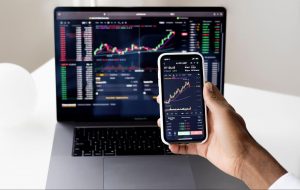What Exactly Is a Stock Scanner?
A piece of software known as a stock scanner is able to search through a large number of stocks in a very short period of time, searching for certain characteristics that you specify.

You may ask it to locate companies that are setting all-time highs on greater than usual trading volume, or you can ask it to search stocks that fulfill any other criterion you want to see, and it will show you with every stock that meets your chosen criteria.
You will spend less time and effort thanks to scanners, and you will be able to concentrate on the best prospects for trading based on the parameters you choose. Click here for more on trading parameters. In a nutshell, they are phenomenally important difference makers that no investor should be without.
Both the words “stock scanners” and “stock screeners” are probably familiar to you if you’ve spent even a little amount of time in or around the financial markets.
Do they refer to the same thing? What’s the difference between the two?
There are certain distinctions in between scanner and a screener, despite the fact that both of these names are often used interchangeably. If we want to be totally technically accurate, however,
It all boils down to efficiently scanning different time periods.
When the web was just getting started, people started developing stock screeners. These were websites that required you to check in at the end of each day and search for fundamental criteria, such as whether or not a stock was trading above its moving average.
Screeners are relatively low tech and are often used in trading for the longer term
However, the development of the internet and other technologies led to the invention of stock scanners. It’s a sophisticated application that runs on your computer and is linked to a data stream, and it constantly monitors various stock markets for possibilities to trade in real-time.
The stock scanner has recently become a popular tool
These products come with their scanning parameters fully pre-configured, and those settings include bullish, bearish, and neutral alternatives. They remove the element of uncertainty from your trading selections by giving you an analysis of equities that have been thoroughly inspected.
These stock scanners for day trading enable traders to select extra criteria such as price brackets, daily threshold volume, and platforms. They come pre-built in the majority of trading platforms. In addition, traders have the ability to design their own scans by utilizing the filter configuration windows provided by the platform. However, for those who aren’t familiar with the process, the sheer volume of accessible images may seem scary and overpowering.
Both the words “stock scanners” and “stock screeners” are probably familiar to you if you’ve spent even a little amount of time in or around the financial markets. Do they refer to the same thing? What’s the difference between the two?
There are certain distinctions in between scanner and a screener, despite the fact that both of these names are often used interchangeably. If we want to be totally technically accurate, however,
It all boils down to efficiently scanning different time periods
When the web was just getting started, people started developing stock screeners (https://www.investopedia.com/terms/s/stockscreener.asp). These were websites that required you to check in at the end of each day and search for fundamental criteria, such as whether or not a stock was trading above its moving average.
There is a dizzying array of stock scanners available on the market today. Because of this, it is difficult to determine with absolute certainty what scanner seems to be the best. Everything relies on you, including your trading strategy, trading plan, budget, technical demands, requirements for market access, and a great many other factors.
Some scanners are operated via a point-and-click interface. To begin a scan, all that is required is to click a few buttons. When dealing with others, you could need advanced programming abilities and understanding of statistics.
Have a limited amount of computational power? You also have the option of using a scanner that operates inside a browser. You may use a desktop-based scanner if you have the want for something more intensive; however, you will need a strong computer to do so.
And what exactly do you mean by the price? Once again, there is no clear pattern to follow. You will be required to make an upfront payment of hundreds of dollars or so for some software application. And with some, the payment may be made on a predetermined schedule each month.
The distinctions between scanners could be discussed in great detail forever…
Find a scanner that works well with the way you trade, and use that one. This is the most important thing you need to know.

Fundamental Stock Scanners
These scanners look for a few essential requirements at the very least.
The statistics, such as ratios and metrics, that are included in fundamental analysis pertain to the business operations of a certain firm. Measuring earnings-per-share (EPS), profit margins, return on equity (ROE), and other financial metrics may also fall within its purview. Click here for more information on earnings-per-share.
If you employ fundamental analysis, you may program a scanner to notify you of any stock that is trading at a total cost ratio that is less than 10, for example. This would be an ideal situation for you to buy the stock. This is only the beginning of the process. After the scanner has returned an individual securities, you will be able to do more research on the tickers on this list.
Scanners for Technical Analysis of Stocks
Those traders who are interested in technical analysis may program their scanners to seek for particular price action, chart pattern, technical indicators, and trading volume requirements (https://capital.com/trading-volume-definition). In a nutshell, they are looking for certain criteria for technical analysis.
If you are one of those traders, you may program a scanner to discover all equities that are technically in an uptrend, have more than one million dollars worth of trading volume each day, as being above a 200-day moving average of the stock’s price.
As soon as you get an individual securities, you can begin doing research to whittle it down to the prospects that are most promising.




Leave a Reply